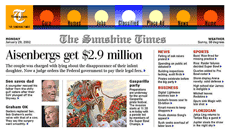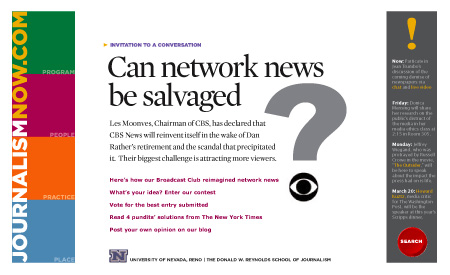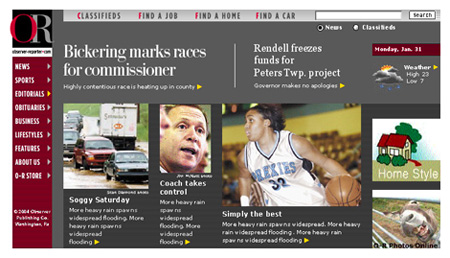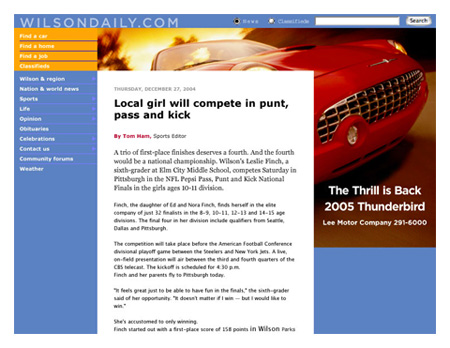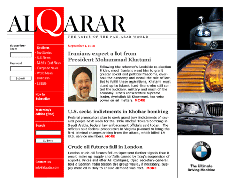Seventeen Pulitzers in 18 years.
Once upon a time, you couldn't hear about The Philadelphia Inquirer without hearing about the remarkable number of awards won under Gene Roberts. This statistic is conspicuous by its absence from almost all the stories about the Inky and the sale of Knight Ridder.
Roberts' brand of journalism impressed Pulitzer jurors but didn't matter much to people in Manayunk, Moyamensing and Mayfair. Outside the city, readers in the surrounding counties didn't care that national and international stories were staff produced. They subscribed to suburban papers for the information they cared about.
The Inquirer had some of the best journalists in the country working on its Neighbors sections. But it didn't consistently divert enough of its award-winning reporters to cover suburban communities and compete with the smaller, surrounding dailies.
Now The Inquirer goes begging for a buyer.
Lesson learned in Philadelphia: Journalism awards do not drive daily readership. This is a disquieting assertion, but the logic is undeniable:
Most journalism awards go to the unusual – outstanding coverage of spot news or in-depth coverage of the latest threat to a community. By their very nature these stories do not appear on a regular basis – thank goodness.
I grew up reading The Inquirer, but I didn't read it everyday for Richard Ben Cramer or Barlett & Steele because Richard Ben Cramer and Barlett & Steele didn't appear everyday. We can't expect readers to buy the paper every day in the mere hope that extraordinary content will be there. Consumers don't like crap shoots.

What newspapers should do: Create awards for journalism that promotes daily readership. If editors and publishers want the kind of journalism that promotes daily readership then they should offer awards to motivate journalists to produce content that readers care about. These honors would go to stories that are interesting, compelling and relevant – even if they aren't particularly “important” or award-winning by today's standards.
Working with Mary Nesbitt of The Readership Institute, we developed a prescription for newspapers. According to Mary, “we must enlarge our definition of what constitutes “good journalism.” Few newspapers have enhanced the consumer experiences that we know are linked with higher readership."
Journalism awards are given to journalists by journalists for stories that are often too long for readers. According to Ed Miller, former editor and publisher of the highly innovative Morning Call in Allentown, Pa, “(A) flaw in the culture of journalism is taking its toll: a general indifference to readers that borders on disdain."
There are plenty of awards for extraordinary stories but few for the kind of journalism that drives daily readership. Every journalist wants to be an award-winning journalist, so newspapers should tap this motivation by offering awards to journalists who produce readership-driven content.
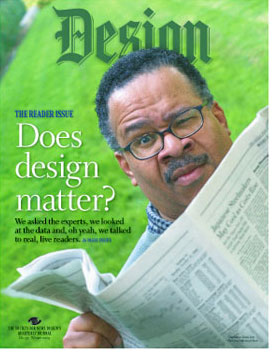 Editors should begin the process of identifying award-worthy, readership-driven journalism. To see what I mean, visit the lively discussions at visualeditors.com to see how members of Society for News Design are debating the need to redesign their competition to promote the kind of design that matters to readers.
Editors should begin the process of identifying award-worthy, readership-driven journalism. To see what I mean, visit the lively discussions at visualeditors.com to see how members of Society for News Design are debating the need to redesign their competition to promote the kind of design that matters to readers.

They didn't know the way in San Jose
The Mercury News made more than $100 million in 2000, compared with just $20 million last year according to Morgan Stanley, says Neal St. Anthony in the StarTribune. It suffered a huge loss of help-wanted ads after 2000, in part due to competition from the Internet.
Ironically, Tony Ridder planted KR's corporate flag in Silicon Valley to show his company's commitment to the Internet. But KR's online classified products did not capture classifieds as they migrated from print to online, which helped reduce margins to unacceptable levels.
This very scenario was predicted in a story published by SND in 1998 – before Craig and his list were much more than a hobby:
Classified advertising will migrate from newspapers to online competitors. This will prompt budget cuts to preserve margins, resulting in newsroom reductions.
That's a complex chain of events but connect the dots and you'll find the logic undeniable.
Lesson learned in San Jose: Classified migration is a cancer that can eat the heart out of your newsroom.
The results are not inevitable for all newspapers even if it's too late to “Save the Merc.” And the threat is not limited to classifieds anymore. Now it extends to online retail advertising.
John Morton reports that online readership and online advertising are both growing at a double-digit rate. This sounds promising until you dig deeper.
Morton goes on to say that online advertising remains meager – only 5% of total revenue. Much of this online revenue is not Internet-only; it comes from automatic upsells from print classifieds. A Borrell Associates study found that 36% of online revenue comes from print upsells. This is just an average. Many papers in this study had much higher percentages of revenue from upsells.
“Remove print classified “upsells” and other financial stipends, and very few newspapers' online editions are actually profitable solely from their own operations. Almost all depend on newspapers for content and financial support,” according to Vin Crosbie.
Follow the money. Online newspapers depend upon content produced by newsrooms which are funded by print advertising – classified advertising that is migrating to online competitors and display advertising whose rates are set by print penetration which continues to fall. Follow this logic to see that the river of revenue to support online could run dry before our boats are floated by Internet-only advertising.
What newspapers should do: Redesign their online sites to be more effective for advertising. We need to see our newspapers and online sites the way readers do – not as editorial content and advertising, but as information. For instance, when readers want to know the movie times, they don't care if that information appears in an ad or within a newsroom-produced list.
Newspapers need to understand that they're managing information. Then they can tap into the information management expertise at their disposal – the writers, editors and designers in their newsrooms.
Online newspaper design is seriously flawed. The biggest problem is usabilty. Newsroom designers could improve online usability if only they had the chance. But many newsrooms have had little to say about the look and feel of their online sites because corporate owners like Newhouse and Knight Ridder wanted it that way.

It may sound crazy, but that 1998 SND story suggested that news designers should redesign online classifieds to save their newsroom jobs.
Usability is important for both editorial and advertising content. According to a recent report by Classified Intelligence of Atlamonte Springs, Fla., “What you don't want to do is create a frustrating, counterintuitive user experience. Any sales rep will can tell you it takes a lot more energy (and money) to win over a customer who already has a bad first impression of you.”
Last week's redesign of NYTimes.com showed improvements to usability. Conspicuous by its absence was an attractive environment for retail advertising or a Google-like interface to search classifieds.

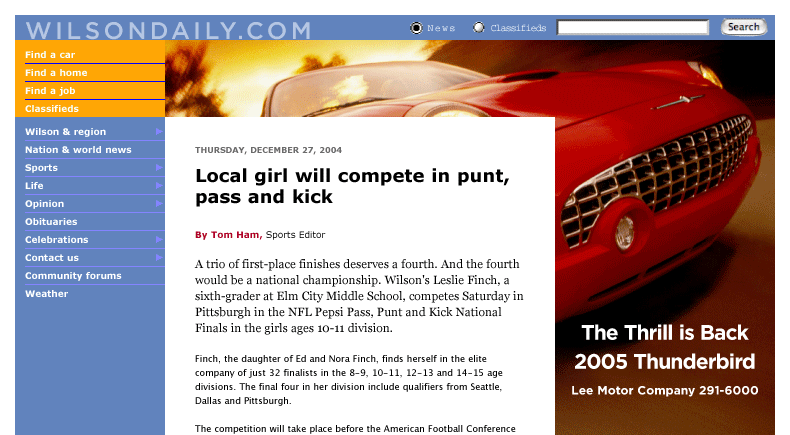


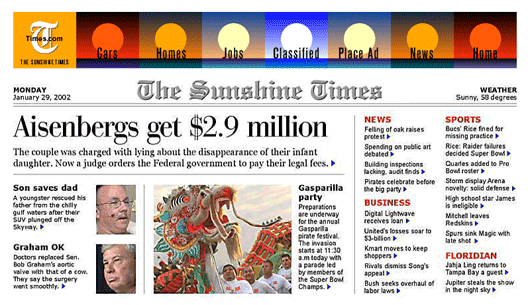

This isn't about blurring the distinction between editoral and advertising or eliminating the separation between church and state. According to Ed Miller, “Because our industry has been financially fat and happy for decades, journalists have been lax about the business of newspapers, often referred to as “the dark side.” We treat people in marketing, production and circulation like awkward cousins from the sticks: We have to acknowledge their presence in the family, but we find it a bit embarrassing to be with them. Most of the time we ignore them.”
We need to tap into the information at our disposal – editorial and advertising – to save ourselves. And that's what some newspapers are doing.
According to Classified Intelligence, The Rocky Mountain News and The Denver Post offer shoppers an online experience that combines classified and retail ads with news articles in one results set. Classifieds appear in a user's search results along with articles from the newspaper, retail advertisements, discussions on the site's blogs and community media contributions.
At The Bakersfield Californian, search results include classifieds, news, directory listings, Web site content, community information, event information and links to print display ads.
Once upon a time, you couldn't hear about The Philadelphia Inquirer without hearing about the remarkable number of awards won under Gene Roberts. This statistic is conspicuous by its absence from almost all the stories about the Inky and the sale of Knight Ridder.
Roberts' brand of journalism impressed Pulitzer jurors but didn't matter much to people in Manayunk, Moyamensing and Mayfair. Outside the city, readers in the surrounding counties didn't care that national and international stories were staff produced. They subscribed to suburban papers for the information they cared about.
The Inquirer had some of the best journalists in the country working on its Neighbors sections. But it didn't consistently divert enough of its award-winning reporters to cover suburban communities and compete with the smaller, surrounding dailies.
Now The Inquirer goes begging for a buyer.
Lesson learned in Philadelphia: Journalism awards do not drive daily readership. This is a disquieting assertion, but the logic is undeniable:
Most journalism awards go to the unusual – outstanding coverage of spot news or in-depth coverage of the latest threat to a community. By their very nature these stories do not appear on a regular basis – thank goodness.
I grew up reading The Inquirer, but I didn't read it everyday for Richard Ben Cramer or Barlett & Steele because Richard Ben Cramer and Barlett & Steele didn't appear everyday. We can't expect readers to buy the paper every day in the mere hope that extraordinary content will be there. Consumers don't like crap shoots.
What newspapers should do: Create awards for journalism that promotes daily readership. If editors and publishers want the kind of journalism that promotes daily readership then they should offer awards to motivate journalists to produce content that readers care about. These honors would go to stories that are interesting, compelling and relevant – even if they aren't particularly “important” or award-winning by today's standards.
Working with Mary Nesbitt of The Readership Institute, we developed a prescription for newspapers. According to Mary, “we must enlarge our definition of what constitutes “good journalism.” Few newspapers have enhanced the consumer experiences that we know are linked with higher readership."
Journalism awards are given to journalists by journalists for stories that are often too long for readers. According to Ed Miller, former editor and publisher of the highly innovative Morning Call in Allentown, Pa, “(A) flaw in the culture of journalism is taking its toll: a general indifference to readers that borders on disdain."
There are plenty of awards for extraordinary stories but few for the kind of journalism that drives daily readership. Every journalist wants to be an award-winning journalist, so newspapers should tap this motivation by offering awards to journalists who produce readership-driven content.
 Editors should begin the process of identifying award-worthy, readership-driven journalism. To see what I mean, visit the lively discussions at visualeditors.com to see how members of Society for News Design are debating the need to redesign their competition to promote the kind of design that matters to readers.
Editors should begin the process of identifying award-worthy, readership-driven journalism. To see what I mean, visit the lively discussions at visualeditors.com to see how members of Society for News Design are debating the need to redesign their competition to promote the kind of design that matters to readers.They didn't know the way in San Jose
The Mercury News made more than $100 million in 2000, compared with just $20 million last year according to Morgan Stanley, says Neal St. Anthony in the StarTribune. It suffered a huge loss of help-wanted ads after 2000, in part due to competition from the Internet.
Ironically, Tony Ridder planted KR's corporate flag in Silicon Valley to show his company's commitment to the Internet. But KR's online classified products did not capture classifieds as they migrated from print to online, which helped reduce margins to unacceptable levels.
This very scenario was predicted in a story published by SND in 1998 – before Craig and his list were much more than a hobby:
Classified advertising will migrate from newspapers to online competitors. This will prompt budget cuts to preserve margins, resulting in newsroom reductions.
That's a complex chain of events but connect the dots and you'll find the logic undeniable.
Lesson learned in San Jose: Classified migration is a cancer that can eat the heart out of your newsroom.
The results are not inevitable for all newspapers even if it's too late to “Save the Merc.” And the threat is not limited to classifieds anymore. Now it extends to online retail advertising.
John Morton reports that online readership and online advertising are both growing at a double-digit rate. This sounds promising until you dig deeper.
Morton goes on to say that online advertising remains meager – only 5% of total revenue. Much of this online revenue is not Internet-only; it comes from automatic upsells from print classifieds. A Borrell Associates study found that 36% of online revenue comes from print upsells. This is just an average. Many papers in this study had much higher percentages of revenue from upsells.
“Remove print classified “upsells” and other financial stipends, and very few newspapers' online editions are actually profitable solely from their own operations. Almost all depend on newspapers for content and financial support,” according to Vin Crosbie.
Follow the money. Online newspapers depend upon content produced by newsrooms which are funded by print advertising – classified advertising that is migrating to online competitors and display advertising whose rates are set by print penetration which continues to fall. Follow this logic to see that the river of revenue to support online could run dry before our boats are floated by Internet-only advertising.
What newspapers should do: Redesign their online sites to be more effective for advertising. We need to see our newspapers and online sites the way readers do – not as editorial content and advertising, but as information. For instance, when readers want to know the movie times, they don't care if that information appears in an ad or within a newsroom-produced list.
Newspapers need to understand that they're managing information. Then they can tap into the information management expertise at their disposal – the writers, editors and designers in their newsrooms.
Online newspaper design is seriously flawed. The biggest problem is usabilty. Newsroom designers could improve online usability if only they had the chance. But many newsrooms have had little to say about the look and feel of their online sites because corporate owners like Newhouse and Knight Ridder wanted it that way.
It may sound crazy, but that 1998 SND story suggested that news designers should redesign online classifieds to save their newsroom jobs.
Usability is important for both editorial and advertising content. According to a recent report by Classified Intelligence of Atlamonte Springs, Fla., “What you don't want to do is create a frustrating, counterintuitive user experience. Any sales rep will can tell you it takes a lot more energy (and money) to win over a customer who already has a bad first impression of you.”
Last week's redesign of NYTimes.com showed improvements to usability. Conspicuous by its absence was an attractive environment for retail advertising or a Google-like interface to search classifieds.


This isn't about blurring the distinction between editoral and advertising or eliminating the separation between church and state. According to Ed Miller, “Because our industry has been financially fat and happy for decades, journalists have been lax about the business of newspapers, often referred to as “the dark side.” We treat people in marketing, production and circulation like awkward cousins from the sticks: We have to acknowledge their presence in the family, but we find it a bit embarrassing to be with them. Most of the time we ignore them.”
We need to tap into the information at our disposal – editorial and advertising – to save ourselves. And that's what some newspapers are doing.
According to Classified Intelligence, The Rocky Mountain News and The Denver Post offer shoppers an online experience that combines classified and retail ads with news articles in one results set. Classifieds appear in a user's search results along with articles from the newspaper, retail advertisements, discussions on the site's blogs and community media contributions.
At The Bakersfield Californian, search results include classifieds, news, directory listings, Web site content, community information, event information and links to print display ads.
